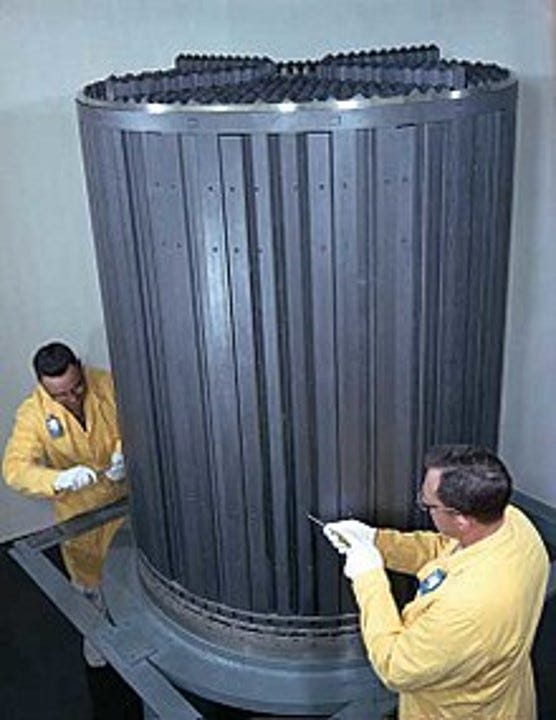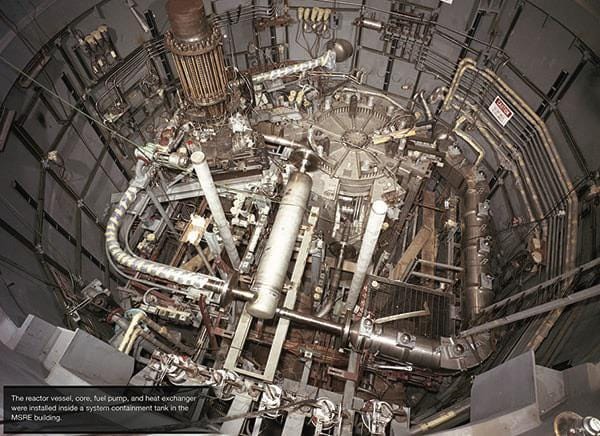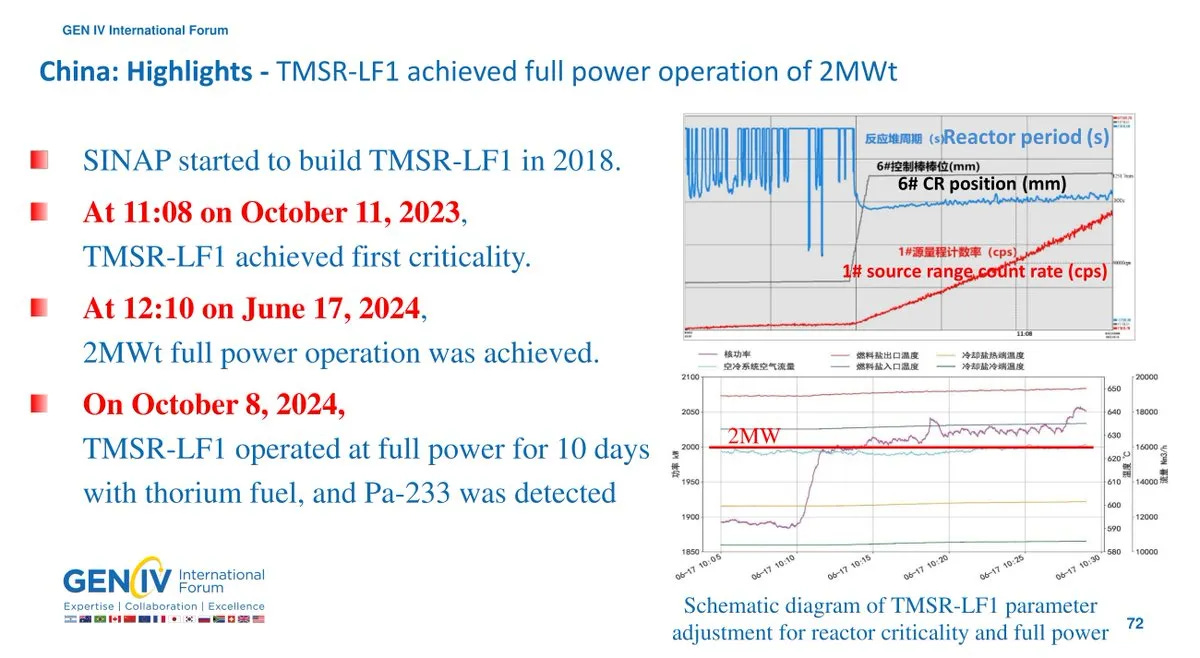Why China's Thorium-Fueled TMSR-LF1 Reactor is a Really Big Deal
Part I: Development History of the TMSR-LF1 Thorium-Fueled Molten Salt Reactor
Most of my research focuses on how to make nuclear energy cost less than fossil fuel energy, by mass-producing many times more reactors than we have today—in factories, on fully robotic assembly and test lines (See The Nuclear Henry Ford Moment for details). The thermal spectrum molten salt breeder reactor (TS-MSBR)—which is primarily fueled by Thorium rather than Uranium—is my favored technology solution for achieving that goal.
Most of the major systems needed to build a fully functional TS-MSBR were proven to work more than half a century ago at the Oak Ridge National Laboratory (ORNL), but sadly, nuclear energy became politicized in the 1970s, and the TS-MSBR was never commercialized thanks to what I would characterize as very poor decision making by the U.S. Government during the Ford and Carter administrations. But now, half a century later, we’re finally starting to see some progress! Several Western startup companies are now working toward commercialization of the TS-MSBR fuel cycle and reactor design. And even the U.S. Government is finally on the case: Dr. David Holcomb of the Idaho National Laboratory (INL) recently published an excellent paper proposing a design for a proliferation-resistant TS-MSBR.
But when it comes to actually building and operating these reactors, China is way out in the lead, ahead of everyone else. In September 2018, China broke ground on the second fully operational liquid-fueled molten salt reactor ever built. ORNL built the first one way back in the early 1960s. The second one, which China just built, is the very first molten salt reactor ever built, by anyone, which includes has the ability to breed Thorium into fissile Uranium-233. It’s not quite “Thorium-fueled” yet, but it’s one step closer than has ever been achieved before. It’s called the TMSR-LF1.
Many people mistakenly believe that ORNL built a Thorium-fueled reactor during the 1960s Molten Salt Reactor Experiment (MSRE), but that’s not accurate. The MSRE team very much wanted to build a Thorium-fueled molten salt breeder reactor, but that project was cancelled in favor of the Liquid [Sodium] Metal Fast Breeder reactor (LMFBR) constructed at Clinch River. The MSRE team only got as far as building a prototype liquid-fueled, graphite-moderated stand-alone molten salt reactor which didn’t include a breeding blanket, the key component needed to fuel the reactor with Thorium. As you can see in the left photo below, the MSRE reactor didn’t have a breeding blanked encircling the core.


Instead, they used another reactor that had a breeding blanket to demonstrate the viability of converting Thorium into Uranium-233, which was then manually transferred to the standalone MSRE molten salt reactor shown in the photos above. These separate activities proved the viability of both breeding Thorium into U-233 and then using that U-233 to power a liquid-fueled molten salt reactor.
The MSRE team also designed a full-fledged molten salt breeder reactor (complete with breeding blanket and a system for harvesting U-233 and using it to refuel the reactor online). But that design was just on paper, and they never got to actually build it before the MSRE was tragically cancelled in 1973.
In a separate experiment at Shippingport, PA, the MSRE team also proved that a U-233 fuel bundle could produce a true breeder reactor in thermal spectrum (meaning a reactor that actually produces more fissile material than it consumes as fuel—without requiring the much greater cost and complexity of a fast neutron spectrum design). I’ll explain why breeder reactors are so important to the future of nuclear energy in Part II.
Before the MSRE program was cancelled, the team made a detailed project plan showing what it would take to commercialize the full-scale (1 GWe) Thorium-fueled Molten Salt Breeder Reactor, in a 10-year project slated to commence in 1975:



The projected budget over the full 10-year program life was $146 million for R&D, plus $17.5 million in capital costs to support that R&D, plus another $554 million in CAPEX to actually build a commercial-scale 1 GWe operational prototype power plant, for a total project cost of $717.5 million (1975 dollars). The more complex and expensive to build LMFBR project at Clinch River spent more than twice that amount—over $1.6 billion, before the project was cancelled in 1983 in large part because of budget overruns.
The greater cost and complexity of the fast neutron spectrum design of the Clinch River reactor likely contributed to the project’s failure. In my opinion, had we funded the TS-MSBR and stayed the course, by 1985 we’d have had a whole new kind of nuclear energy that could have changed the course of human history and avoided much of the economic pain the world has experienced in the 21st century due to the ever-increasing cost of fossil fuel energy, which is now literally twice as expensive as it was when I was a kid, even after adjusting for inflation.
Before the MSRE was cancelled in 1973, the team proved the viability of most of the major systems required to build a Thorium-fueled thermal spectrum molten salt breeder reactor—which I contend is the “secret sauce” to making nuclear energy cost less than fossil fuel energy by the mid-2030s—but nobody ever actually built one. Until now. And I’m convinced this is just the beginning of China picking up the pieces of the most important nuclear technology the U.S. ever abandoned, and that China will achieve great success commercializing the design originally pioneered by Alvin Weinberg’s MSRE team at ORNL in the late 1960s.
China’s press release (see above) makes clear that SINAP got the green light to start up and test the TMSR-LF1 reactor way back in June 2023, but then there was radio silence for several months. People in the nuclear community began speculating… Did they ever start it up? Was there an accident they were covering up to explain why there had been no further news? It was a complete mystery. Then, on December 7, 2023 (Pearl Harbor Day, no less), China’s propaganda bureau posted a lone tweet thread announcing the expansion of the Thorium MSR program to include Thorium-fueled nuclear container ships:
Few others noticed, but I thought this was huge news at the time. The phrase “the significance of which is beyond shipping” said it all to me: China has the same vision I’ve had for years: Design a “workhorse” generic modular Thorium-fueled MSR, and then mass-produce it in order to seize the economies of scale of robotic assembly-line mass production. Then make thousands and thousands of them for every imaginable purpose from large powerplants comprising several reactors to powering container ships to military vessels to remote mining villages. The “small block chevy of Nuclear Reactors”, if you will.
I was convinced when I saw this tweet that China had grandiose plans for commercialization of the TS-MSBR as a factory-built multi-purpose reactor to support many different applications. Admittedly, that’s a fair bit of speculation on my part, and I’m reading a lot into the above tweet. But that’s my take, in any case.
What ever became of the TMSR-LF1, China’s very first T-MSR test reactor (rated at only 2 MWth), which they built in the middle of the Gobi desert? More than a full year passed after they got startup authorization, without a peep out of China other than the above tweet mysteriously expanding the program to include container ships without explaining why there had been no news about the TMSR-LF1. That led to all sorts of speculation as to whether they’d had an accident they were covering up, etc. Then, finally, the long-awaited news broke. It came as no surprise that Nick Touran of whatisnuclear.com was the first (in my feed, anyway) to break the news on X:
It wasn’t long before Angelica Oung, another prolific nuclear energy advocate, penned an article here on Substack with more detail than Nick’s tweet contained:
In particular, Angelica’s substack post included these stats from the GEN IV International Forum on the timing of events, which apparently just became public in the last week or so:
So what does all of this mean, and where does it leave us? China appears to have already proven everything this reactor was designed to prove:
They constructed this reactor in the middle of the Gobi desert to prove the point that it could operate without cooling water from an adjacent river or ocean, an important improvement over conventional reactors which require a voluminous source of cooling water.
They started the reactor a few months after obtaining authorization, and initially operated it at reduced power (this implies that a thorough and safety-conscious testing and evaluation plan was employed).
After just two months of operation at reduced power, they apparently gained enough confidence in the T-MSR technology to make a public announcement about using these reactors to propel container ships, aircraft carriers, and “significant” other unspecified applications “beyond shipping”. My strong suspicion is that this announcement was a “trial baloon” meant to test how much objection would be voiced in the West to the notion of merchant vessels servicing civilian cargo ports under nuclear power.
They “put the pedal to the metal” and increased to full rated power after more than 8 full months of reduced power operation. This shows a conservative, thorough, safety-conscious approach to testing the new reactor.
After a few more months of full-power operation, they’d moved on to proving the ability of the reactor to breed Uranium-233 (fissile reactor fuel) from cheap, abundant Thorium, a critically important milestone.
It’s unclear (from the data I’ve seen so far) where they stand with regard to the remaining important milestones that need to be proven:
The ability to achieve continuous online fueling, meaning that they can remove Pa-233 from the breeding blanket while the reactor is running, allow it to naturally decay into fissile U-233, and then pump it into the circulating fuel salt to add fresh fuel to the reactor, all while the reactor is running and without requiring shutdown for refueling.
The ability to remove fission by-products from the circulating fuel salt while the reactor is running, a key feature that will allow modern liquid-fueled reactors to achieve much better neutronics than conventional reactors because the leftover fission by-products are what tend to rob a reactor of the neutrons needed to continue a sustained fission chain-reaction after a small part of the uranium in a conventional fuel bundle is consumed.
It’s unclear whether the last two objectives were part of the TMSR-LF1 design. It would be reasonable to save them for a 2nd prototype reactor, because the online fission by-product separation, in particular, is one aspect of the TS-MSBR fuel cycle that was never fully proven by the MSRE at ORNL, and it’s a challenging engineering task that’s never before been achieved.
So what’s the big deal?
I say this is really, REALLY big news. Why? Because after humanity literally wasted more than half a century not developing and commercializing what I think is the most promising nuclear reactor design so-far conceived, China finally built the world’s first thermal spectrum molten salt reactor with a Thorium breeding blanket. As I’ve written about extensively elsewhere, I’m convinced that whoever perfects and commercializes this technology at scale will have a massive competitive advantage in the global economy. And it’s now beyond clear that China is in the lead. By a lot.
Before going on to why I think that’s such a big deal, I want to address this very timely and perceptive tweet I received in reply to reposting Angelica’s excellent article:
While I strongly disagree with the conclusion Casper may be implying here, I couldn’t possibly agree more with the accuracy of his perfectly worded statement: A lot of the Nuclear community have some pretty serious reservations about the “Thorium Bros” and the propaganda they’re guilty of spreading. Thorium-fueled nuclear energy has taken on something of a cult-like following on the Internet, and frankly the “Thorium Bros”, as this cult-like fan club has come to be known, are guilty of spreading more misinformation about Thorium energy than they spread accurate information. For example, they exclaim with great fanfare that it’s absolutely, positively impossible to make a bomb from U-233. (Never mind that a bomb made from U-233 was detonated on the Pokhram Test Range on May 13, 1998, producing a 0.2kt yield). Their other lunatic claims are too numerous (and irrelevant) to list here in detail.
I myself am guilty (particularly, in Ep. 6 of my Energy Transition Crisis docuseries) of repeating some of their “urban legends” about Thorium early on in my own self-education on nuclear energy technology. Much of the Thorium Bros’ lore is unadulterated bullshit, so it should come as no surprise that many properly credentialed nuclear scientists and engineers are skeptical of the claimed benefits of Thorium MSRs and even more skeptical of the “Thorium Bros” who promulgate all sorts of nonsensical propaganda about Thorium-fueled reactors.
When I produced Energy Transition Crisis, I made the mistake of assuming that if I could verify the same information from at least 3 separate sources, then it must be credible. Little did I know that the crazy and sometimes even conspiratorial tall tales told by the Thorium Bros get re-told so many times over that I could have found not just 3 but 300 sources—all corroborating what was still total bullshit at the end of the day.
Now that I’ve hopefully redeemed myself by publicly acknowledging that the Thorium Bros are full of crap on many of their talking points, and have publicly admitted that I’m guilty of having repeated a few of their tall tales early on in my own nuclear journey, I’m going to double down now: I still say the Thorium-fueled TS-MSBR is the most promising reactor design in existence for large-scale deployment of nuclear energy. Not for the silly reasons advocated by the fringe wing of the Thorium Cult, but for solid and well-justified reasons I’ll present in Part II.
And I’m not going to stop there. I’ll even go so far as to (respectfully) suggest that the credentialed nuclear community has become so tainted by the Thorium BS that they’re not taking Thorium reality to heart: It’s the only known way to make a true breeder reactor work in thermal spectrum. And to solve the world’s energy dilemma, we need to figure out how to make nuclear energy cost a whole lot less than it costs today. Mass-produced breeder reactors that avoid the more expensive design demands of fast-spectrum breeders are a natural win, even if all the Thorium Bros’ propaganda on other matters is still unadulterated bullshit.
And by large-scale, I’m not talking about “tripling nuclear by 2050”, the current trendy thing to advocate. I’m talking about a 24x on Nuclear—the amount needed to fully replace all the energy we derive from fossil fuels today. To be clear, I don’t think we need to phase fossil fuels out completely. But I do think we need to figure out how to make nuclear energy cost much less than fossil fuel energy, then roll out as much of it as we have fossil fuel energy today, for the sake of lowering the cost of energy and restoring upward trajectory in our standard of living. This chart explains why that’s so important:
The chart shows that from the end of WWII until 1974, humanity was on a steadily increasing trend in human prosperity, as measured by per-capita energy consumption—the best proxy we have in economic data for measuring our standard of living. After 1974, the chart flat-lined for the balance of the 20th century, and we’ve been in gradual but steady decline for the entirety of the 21st century (thus far). That’s the real reason we have people living in tents on sidewalks today, in stark contrast to the boom times of the 1950s and ‘60s.
I’m convinced that commercializing the TS-MSBR at scale is the best option we have to get humanity back on the steady uptrend in prosperity indicated by the dashed white line on the chart. And now China is way out in the lead, leaving the West to catch up to China’s success. If only we’d stayed the course back in the early 1970s, we could have solved this problem by 1985!
I’ve been getting grief for the length of my Substack posts, so I’m going to break this into multiple parts. Hopefully you found this first part on the history of how we got to the world’s first Thorium-fueled molten salt reactor interesting.
In Part II I’ll dive into why this kind of Thorium reactor is far more suitable for really scaling up nuclear energy to restore an uptrend in our standard of living than conventional light-water reactors or even the kind of Thorium reactors Nick Touran mentioned in his tweet, which were built decades ago at Indian Point and Shippingport. I’m convinced this is a major big deal, and Part II will explain why.
Then Part III will explore why it’s so important that it’s China as opposed to a Western nuclear startup that’s in the lead on this crucially important advanced nuclear technology.











Thanks Erik great post also looking forward to number 2
I am looking forward to part II and III